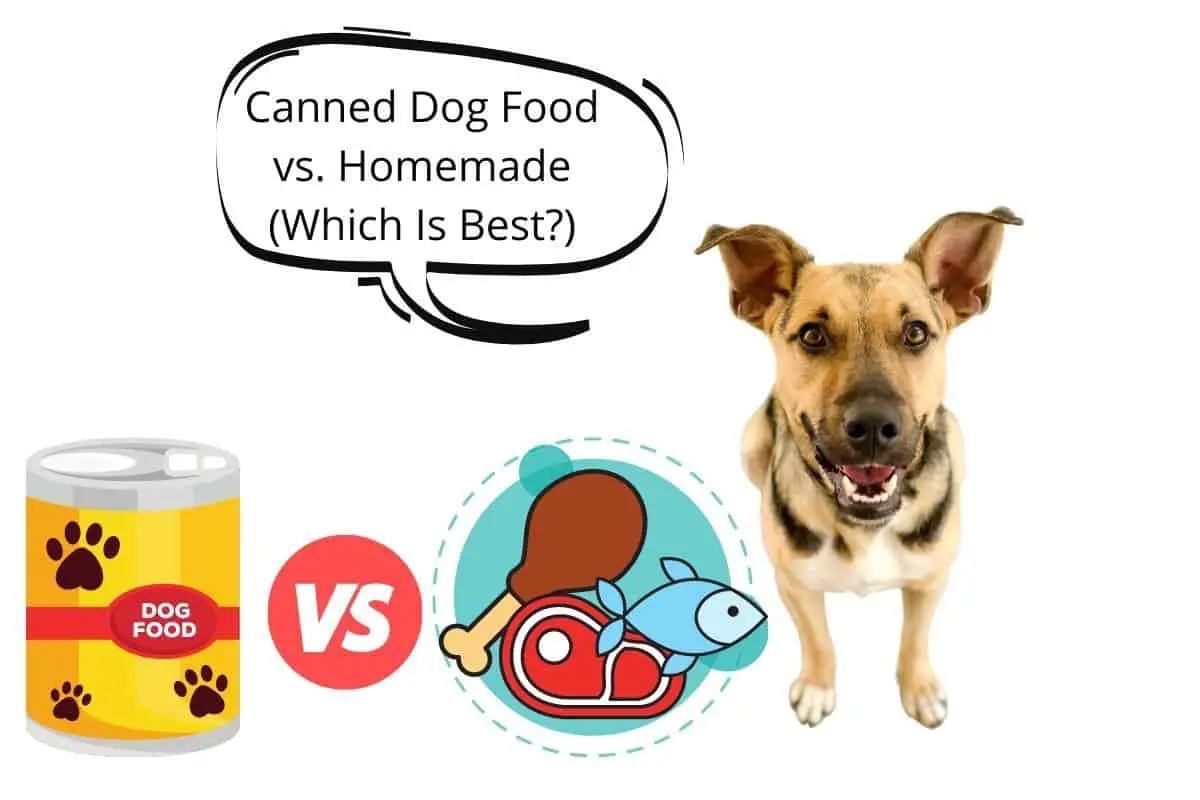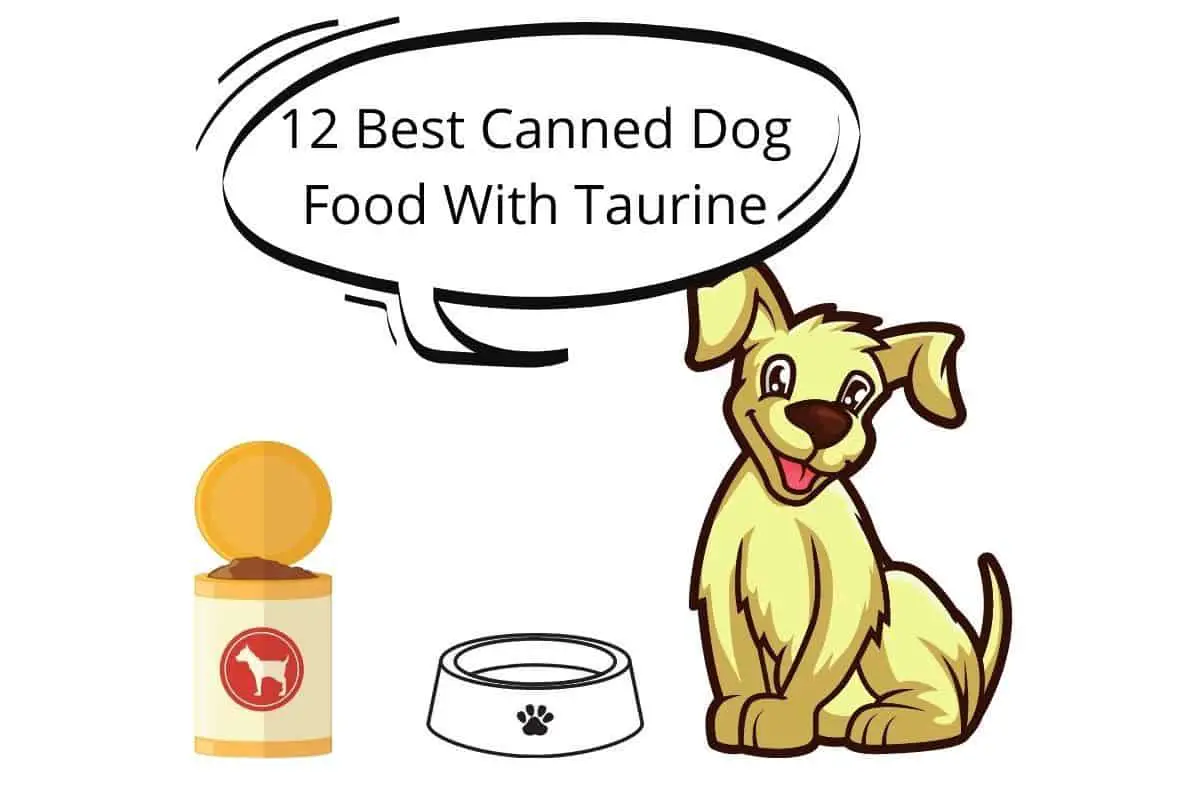This post contains affiliate links.
Canned and homemade dog foods are two nutritious choices to feed your canine friends. They both keep your dog well-fed and healthy; however, they both come with advantages and shortcomings. Which of them is the best food for your dog?
Canned dog food is highly nutritious, well-balanced, undergoes minimal processing, and is best for picky eaters. Homemade dog food is tastier, healthy, and free from allergens, making it best for sensitive dogs. It’s best, however, to serve both choices as dogs tend to enjoy them equally.
In this article, we’ll delve deeper into each of the canine diets to explore their advantages and disadvantages. After reading the article, you’ll be in a better place to pick the right diet from your dog companion.
Table of Contents
Canned Dog Food: A Basic Overview
Canned dog food, also known as wet dog, has grown in popularity in recent years as pet parents realize the benefits it confers to their pets. Unlike dry dog foods, canned dog foods undergo minimal processing.
As a result, wet dog food is a more delicious, healthier, and more nutritious option for your animal companion. The key to canned dog food’s high nutritional value boils down to ingredients and the production method.
- Assembly and grinding of raw ingredients. The raw materials differ as pet food manufacturers use different ingredients in their formulas. However, meats make up the bulk of canned dog foods. Most brands use fresh or frozen meats that are gathered in large batches and ground into small pieces. The ground meat is then mixed with a gravy containing minerals, vitamins, and some grains.
- Mixing and cooking. The ground raw materials are blended in a mixer, and the temperature raised to gelatinize the starch and denature the proteins. The process improves the texture and flavor of wet dog food. Dog food with carbohydrates is cooked at high temperatures to ensure the starches cook thoroughly.
- Canning the food. The thoroughly blended and cooked dog food is transferred to a seamer machine that fills and seals the cans. The device also vacuum seals the food in the can to keep the ingredients from spoiling.
- Sterilization. Once the cans are filled with dog food and sealed, they’re sterilized at 121°C (249.8°F) for three minutes. The high temperature kills potentially harmful microbes such as Clostridium botulinum. The sterilized cans are left to cool before they’re labeled and distributed for sale.
When purchasing canned dog food, you must confirm the “best if used by” date stamped on the can. You’ll find the date at the bottom of the can, and it allows you to plan how long to store the dog food.
Feeding your dog canned food that’s past the expiration date isn’t ideal. While the food might not harm your pet, it might begin to lose some of its nutritional value.
On opening a can of dog food, it’s best if your pet consumes it as quickly as possible. You can preserve an open can of dog food for three days in the fridge, but you should cover the can with tight-fitting lids.
You should not feed your pet from an open can that’s spent more than three days in the fridge as there’s a high chance of food poisoning.
Pros of Canned Dog Food
- Fewer preservatives. Since canned dog foods come in air-tight packaging, they contain no artificial preservatives, coloring, or flavors. The cans allow meats to retain their natural taste and flavors, making for a delicious feast for your dog. Preservatives such as nitrites and nitrates are known carcinogens that can harm your dog.
- Higher protein content. Most wet dog foods use fresh or frozen meats instead of the processed variety. Using real meat ingredients increases the food quality and lends a great taste to the food. As canines, dogs have an instinctive preference for actual meat and therefore enjoy such food more. Dogs hardly require grain-sourced carbs that constitute the bulk of dry foods.
- Flavorful. Since wet foods retain all the juices, fats, oils, and flavors, it tastes better than dry foods, and most dogs find it more palatable. Canned dog food is ideal for picky eaters because they come with a strong natural flavor. Less carbohydrate content eliminates the need for artificial flavors typical in dry dog food.
- Promote weight loss. Canned dog foods have a high moisture and protein content. The food keeps your dog hydrated and feeling full for a long time since protein has a long digestive process. Wet dog food prompts healthy weight loss and helps your pet maintain the ideal body weight. It also helps your dog build muscle instead of gaining unhealthy fat.
- Superior quality. Wet foods have a higher protein content, few artificial preservatives, and lower carbohydrate content. Kibble is high in carbohydrates because the carbs double as binders to keep the food from crumbling. Since carbs aren’t a priority, canned dog food is rich in proteins, minerals, and vitamins.
- Easier to chew. Young puppies and dogs with dental issues have an easier time eating soft canned foods. The crunchy kibble can pose a challenge to old or sick pets as it requires active chewing to break it down. Wet dog food is easier on your dog’s mouth and stomach, especially when they’re ill or aged.
- It’s healthier. Canned dog food is pricier than dry food partly because it contains high-quality ingredients. Unlike kibble, wet food isn’t sprayed with fats and animal digests to appeal to the dog’s taste buds. Canned foods contain whole meats, organic veggies, fruits, healthy fats, antioxidants, minerals, and vitamins. Wet food improves your pet’s health because it’s not over-processed.
- Reduces bloating. Dogs fed on canned foods are less likely to bloat since the wet food doesn’t soak up most of the liquid in their stomach. Because of their wet nature and solid constitution, canned foods aren’t easy to gulp. Gulping dry foods is a leading cause of bloating in large dogs. Large, barrel-chested dogs such as Great Danes benefit greatly from canned foods since they’re prone to bloating.
- Long shelf life. Due to the efficient production method, canned dog food lasts for a long time. Most brands have a shelf-life of between 2 and 5 years from the canning date. While undamaged canned food can last much longer than that, it’s advisable to toss it out if it outlasts the ‘use by’ date. However, you should refrigerate open cans and ensure your dog consumes the food in three days.
Cons of Canned Dog Food
Despite the glowing advantages, canned dog food comes with several drawbacks, including:
- It’s more expensive. Canned dog food is pricier than dry food, mainly due to its superior quality and higher protein content. However, this drawback is offset by the numerous health benefits your pet stands to gain.
- Some companies are dubious. You must trust that the company is honest about food quality, ingredients, and the manufacturing process. Luckily, there are numerous online reviews to help you zero in on reliable canned food brands.
- Some dog food cans may have BPA. Some canned dog foods can increase your pet’s exposure to the endocrine-disrupting chemical. While this is a severe concern, you can easily overcome it by sticking to dog food brands that use BPA-free containers.
- Some brands use meat byproducts. Some cheap brands skimp on choice meat cuts and lower the quality of their wet foods. Carefully reading the label can help you identify such brands and avoid them.
Homemade Dog Food: A Basic Overview
Dogs are omnivores who thrive on a diet of proteins, carbohydrates, fruits, vegetables, and fatty acids. Many pet parents find it easier to feed their dogs homemade meals as a more convenient way to help them meet their nutritional needs.
Since dogs are omnivores, there’s a massive overlap between their diets and that of humans. Many people love cooking for their dogs as much as they do for the rest of the family.
Despite the considerable overlap, a dog’s nutritional requirement is vastly different from that of humans. They require more content, calcium, and minerals in their diets than we do.
A balanced homemade dog meal contains different food groups to ensure that the pet gets an adequate supply of nutrients.
Most homemade dog food recipes advocate for high-value protein sources such as muscle meat, liver, fish, and eggs. The fat content comes from safflowers, canola, fish, or olive oil. Salmon and cod are the most popular fish oils in homemade dog foods.
Sweet potatoes, brown rice, barley, and oats make excellent sources of fiber-rich carbohydrates in home cooked dog food. You can substitute whole-grain pasta for barley if your dog prefers pasta.
Lastly, a healthy home-cooked dog meal needs a phytochemical source such as vegetables, fruits, or herbs. You can serve your dog raw veggies such as alfalfa sprouts, chopped parsley, grated carrots, soft peeled squash, and zucchini.
It’s best to cook hard winter squash, peas, broccoli, and green beans before serving them to your dog.
Like kids, some dogs dislike veggies, preferring fruits instead. In such an instance, it’s better to substitute veggies with fruits since they complement the meat rather well.
Occasionally, you can use beans, cottage cheese, yogurt, and tofu as protein sources. Before incorporating these food items, ensure that your dog isn’t intolerant to them.
Some dogs experience flatulence and gastrointestinal problems on consuming soy, beans, and dairy products. Test for tolerance by introducing new foods in small quantities and observing for reactions.
It’s advisable to cook homemade dog food in batches for ease and convenience and then store the surplus later. You can portion the extra food into reusable and washable food containers then freeze it until you need it.
Batch cooking homemade dog food ensures that your pet has plenty of delicious and nutritious food at the ready. You get to save time and effort by eliminating the need to cook for your canine friend daily.
You can store cooked dog food in the refrigerator safely for three days before spoilage becomes a health concern.
For the best results, when using homemade dog foods, you should consult a veterinary nutritionist. Seeking out expert advice can ensure that you’re providing your dog with a balanced diet the pet needs to stay healthy.
You can also treat your pet with a mix of raw and home-cooked food to ensure they have the best of both worlds.
Pros of Homemade Dog Food
- Broad choice of nutritious foods. You only ensure that the home-cooked dog meal contains items from different food groups to whip up a healthy treat. That allows you the latitude to try out different food combinations to keep your pet happy and healthy. Experimenting with different combinations yields different results, turning each meal into a nutritious feast.
- Tastier than commercial dog food. Homemade food is wholesome and delicious because it’s made in small batches and carefully prepared. Since you have a free hand in picking the ingredients, you can use choice meat cuts instead of processed meats. You can vary the ingredients and keep your dog’s taste buds tingle each day.
- Minimal processing. Home-cooked dog meals undergo minimal processing, if any, compared to commercial feeds. In most cases, you’ll pick raw ingredients from the store before preparing a meal. Unprocessed ingredients are healthier, low in sugars, and rich in vitamins and minerals. Healthy foods improve your pet’s health and wellbeing while lowering your vet bills.
- You know exactly what’s in the dog food. Pet parents are wary about the ingredients used in commercial dog foods, and rightly so. Some brands have been the subject of safety recalls due to contamination, use of inferior ingredients, and more. With homemade dog food, you have full control over the ingredients and know exactly what goes into the bowl.
- Adaptable to changing dietary needs. Like humans, a dog’s nutritional needs change as it ages or develops new health issues. Commercial dog food isn’t well-placed to meet the changing dietary requirements. But you can tweak home-cooked dog food to incorporate a vet’s advice to cater to the changing nutritional needs. You can easily swap certain ingredients or alter their quantities to suit your dog’s feeding routine.
- Caters to fussy eaters. Some picky eaters ignore commercial feeds for hours, but they will readily gobble bits from your plate. Such dogs aren’t keen on the taste or texture of store-bought foods. Switching to homemade dog meals is the best action plan instead of spending a small fortune trying out different brands. With home-cooked meals, you can ensure that your pet is well-fed each day.
- Easy to avoid allergens. It’s easier to cater to a dog’s needs with a sensitive stomach or is intolerant or allergic to some ingredients. If your pet has severe allergies, you’re better off with home-cooked meals. Commercial feeds may not list an allergen as an ingredient, but it may be present in the production line. Preparing dog meals at home helps avoid such eventualities.
- It lacks preservatives. Home cooked dog food is free from harmful preservatives, artificial flavors, or synthetics ingredients. That makes for healthier meals that your pet will enjoy and benefit from them. The use of whole food ingredients promotes a dog’s immunity to fight off diseases and infections.
- Great bonding experience. Cooking for your animal companion makes for a fulfilling experience for both of you. It’s a great source of pride and joy to watch your dog slobber over a meal you prepared specially for them. It also lets you take a greater interest in their health and wellbeing. Homemade dog meals push you to learn about nutrition and dietary preference.
Cons of Homemade Dog Foods
- They can be unhealthy. It’s easy to feed your dog a favorite meal frequently without considering the ingredients and nutritional content. It’s easy to unwittingly put your dog at risk of nutritional deficiency despite providing for them several times daily.
- It’s not easy to achieve a completely balanced diet. Despite your best efforts to get the best ingredients, your gourmet dog food might fall short on nutrition. Some crucial minerals are not readily available in foods or are available in minimal quantity. That means you’d need to buy supplements to ensure a balanced meal.
- They are expensive to make. Unlike the mass-produced commercial feeds, homemade dog food is costly. Choice ingredients carry a premium price tag that might strain your finances.
- It’s time-consuming. While satisfying, cooking for your dog is a time-intensive affair, just like making homemade foods. It might not be feasible if you have long days at work and other family obligations.
Final Thoughts
Canned dog foods are high in proteins, highly nutritious, and undergo minimal processing before put into cans and sealed. This helps preserve the taste and lock the flavor of the ingredients. While dogs find them delicious and filling, you have no control over food quality and its components.
Homemade dog foods are healthy, delicious, and put you firmly in-charge of your pet’s diet. You can cook dog food in batches and stow them away in the freezer for future portions. However, it’s advisable to complement home-cooked dog meals with supplements to ensure the dog gets the necessary nutrients and minerals.
Related Articles
- 7 Reasons Why Canned Dog Food Needs To Be Refrigerated
- A Dog Owner’s Guide to Canned Dog Food and Diarrhea
- Canned Dog Food vs. Freeze-Dried Dog Food Compared
- 4 of the Best Places To Store Canned Dog Food
- A Guide to Heating Canned Dog Food (How and Why To Do It)
- Common Ingredients of Canned Dog Food Revealed
Sources
- Whole Dog Journal: How to Make Homemade Dog Food
- Whole Dog Journal: Which Type of Dog Food is Best?
- Dog Food Advisor: Canned or Dry Dog Food… What’s the Better Choice?
- Homes Alive: 13 Canned Dog Benefits
- WebMD: Make Homemade Dog Food
- Bark: Save Money with Homemade Dog Food
- Daily Dog Stuff: How to Store Canned Wet Dog Food (& how long does it last?)
- Dog Naturally Magazine: Raw Dog Food: Homemade VS Store-Bought
- Dog Food Insider: How is Canned Dog Food Made?
- Pets Radar. What are the Benefits of Homemade Dog Food?
Mrdogfood.com is a participant in the Amazon Services LLC Associates Program, an affiliate advertising program designed to provide a means for sites to earn advertising fees by advertising and linking to Amazon.com. We also participate in other affiliate programs which compensate us for referring traffic.




